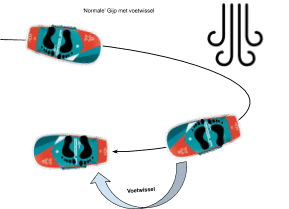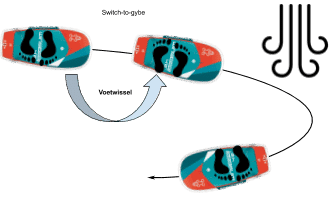How do you learn wingfoil jibes quickly and well?
Suppose you are a wingerfoiler and flying lukt all good. Then your next big challenge is the (flying) wingfoil-jibe. Our experience with the wingfoil jibe is that it requires quite a bit of practice. That’s why in this blog we give some tips to learn to jibe.
When you’re jibes, speed is your friend’s
Especially in the beginning it is quite exciting to start a jibe with speed, but in the end speed makes it easier to help you wingfoiling through the jibe. If you start the jibe with a little speed, you will need to generate less power during the manoeuvre and that will give you the space to pay attention to your posture, hand and footwork.
The wingfoil mortar step by step
Dividing the jibe helps you to tackle it in a controlled way. This allows you to practice on the part which requires the most attention. The jibe involves a number of aspects such as foot control, the foot change, and the repacking of the wing. These actions can be practiced on land by going wing skate or during straight raking on the water. It is also useful to practice on switched stance sailing (where your toes point towards the wind). By practicing these parts separately, you use the jibe with more confidence.
Experiment with the foot change
Unlike windfoil, there is no standard point in the jibe where the foot change is used; In fact, you don’t even have to use a foot change. Nevertheless, switched stance sailing is relatively difficult and inefficient, which is why in practice we always make a foot change. Then the question remains whether you make the foot change before or after the jibe?
With the regular wingfoil gijp (photo left) you start in the normal position and change your feet after the jibe. The advantage is that this foot change is relatively easy to use, because you start with your feet at the ‘normal’ position with your toes off the wind. The disadvantage is that the exit of the jibe is slightly more unstable, which makes you more quickly out of balance. At the (photo right) you start with a foot change before you use the hijack. A big advantage is that you have already had the hardest part for the hostage. So you can prepare well for it, but to then keep enough speed to get through the jibe planning requires some practice. Practicing with the foot change on land or during wingfoiling helps you to build confidence before hijacking.


Hand’s up!
When winging, it is not always easy to determine the correct position for the wing. When you move your front hand above your head when you deploy the jibe, it gives room for a smooth transition. By moving your hands upwards you de-power the wing and put it in a position that makes it easy to take the wing. In the starboard team rider Zane Schnweitzer takes the most important steps of the wingfoil gijp with you and gives extra attention to this tip.
Take your time and perserage!
Maybe it’s an open door, but don’t give up if the foil jibe doesn’t work right away. Wing foiling is relatively easy to learn, but pay attention; a wingfoil jibe requires a lot of practice and that includes the necessary crashes. Keep your cool and stay committed. Really don’t want to make it? Then we are happy to help you during a Wing foil or Wing skate lesson.
Wingfoil jibe tips
Finally, some quick tips & Tricks for before and during the practice of the wingfoil-gijp. Good luck!
- Break it down: step by step work towards the foiling jibe.
- Practice turning the wing on land.
- Choose the right conditions: practicing with wingfoil jibing is easier with flat water and a lot of wind than in choppy conditions!
- The difference with/without foot streps is large. In general, it is easier with the two front foot streps mounted because then you know exactly where your feet should be.


